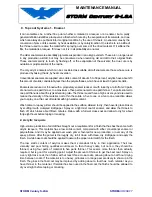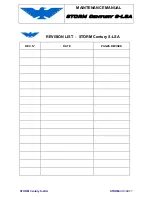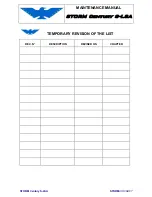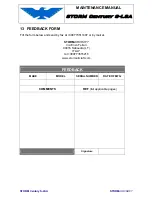
MAINTENANCE MANUAL
STORM Century S-LSA
STORM Century S-LSA
STORMAIRCRAFT
Use zinc chromate primer as a dielectric between the two metals. Spray both pieces and join
them while the primer is wet. Wipe off the excess after the p e t s are together, and finish as
required.
B. Primers
After the surface has been properly pre-treated, a primer is applied to provide a good bond
between the metal and the topcoats. For years, zinc chromate has been the standard primer
for air-craft use because of its good corrosion resistance. But, since it does not provide as
good a bond to the surface as some of the new primers, its use is decreasing. Two-component
epoxy primer is re-commended.
1. Wash primer
High-volume production of all-metal aircraft has brought about the development of a primer
which provides a good bond between the metal and the finish, and which allows the topcoat
to. be applied after only aboub a half-hour cure. These primers can be used on aluminum,
magnesium, steel or on fiberglass. Acrylic or enamel topcoats can be applied directly over the
wash primer, but for maximum protection, such as required for seaplanes or agricultural
aircraft, an epoxy primer should be applied over it.
When wash primer is applied over a properly cured conversion coating, the organic film of
the wash primer bonds with the inorganic film and provides excellent adhesion between the
topcoat and the surface. It also provides good protection for the metal.
Wash primer is a three-component material. Four parts of primer are mixed with one part of
acid diluent and four parts of thinner and allowed to stand for twenty minutes to begin its
curing action. Restir, and spray on the surface. The viscosity is adjusted by the addition of
more thinner in order to get the extremely thin film required, but never use more than 8 parts
of thinner to 4 parts of primer.
Wash primers should be applied with a film thickness of not more than 0.3 mil (0.0003 in.,
0.0076 mm). This can be determined by looking at the surface. A film of proper thickness will
not nearly hide the surface, but will give a slight amber cast to the aluminum.
One of the main reasons wash primers are so popular for production is the fact that they may
be topcoated in a short time after their application without the finish sinking in and losing its
gloss. The acid requires about thirty minutes to convert into the phosphate film, so the
topcoat must not be applied until the conversion has finished; but it must be applied within
eight hours, or the glaze on the primer will be so hard that the topcoat will not adhere to it.
Every effort should be made to topcoat wash primer within this time frame of one to eight
hours; but if it is absolutely impossible to finish within this period, another coat of primer must
be applied over this first one. Omit the acid when mixing the primer for the second coat and
when it is going to be used over fiberglass or plastic.
About the most critical aspect of the application of wash primers is the necessity of having suffi-
cient moisture in the air to properly convert the acid into the phosphate film. It has been proven by
much research that proper conversion requires nine-hundredths of a pound of water for every
pound of dry air during the application of the primer. It is not really difficult to know exactly how
much water is in the air .









































